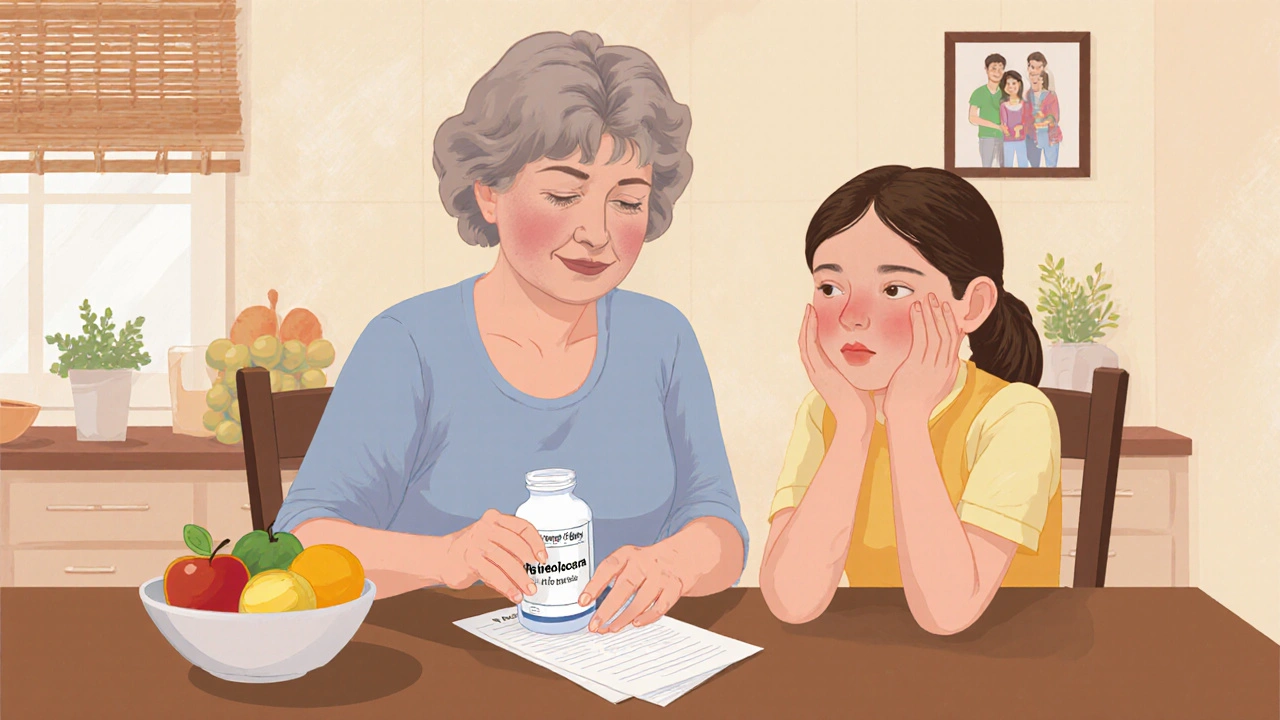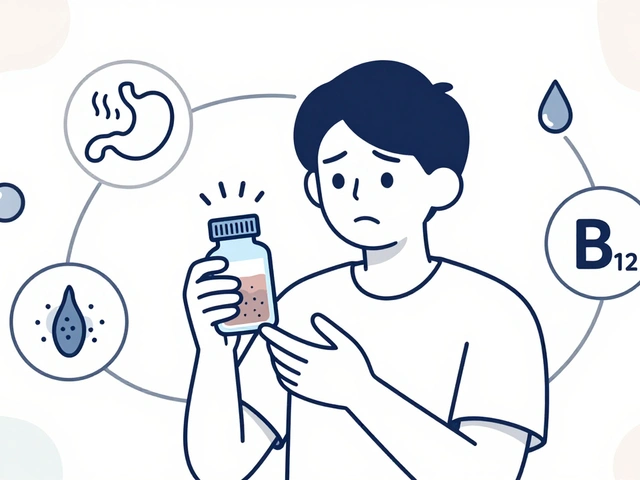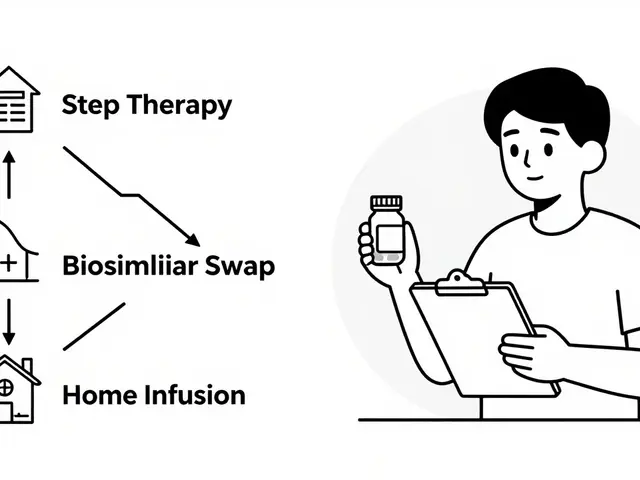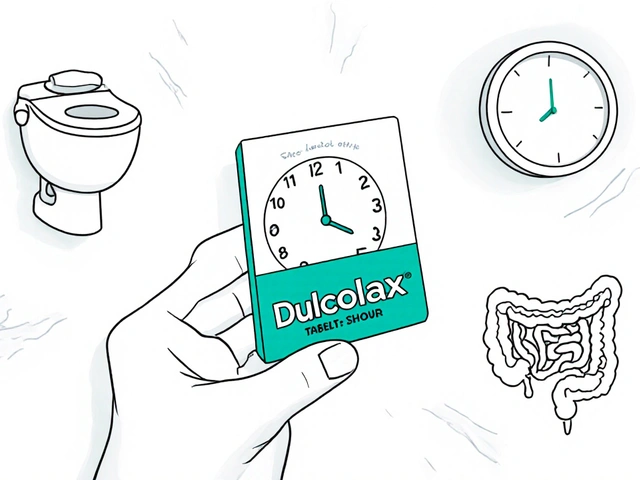TL;DR:
- Angioedema causes unpredictable swelling that can halt everyday activities.
- Physical pain, facial disfiguration, and breathing risk fuel anxiety and social avoidance.
- Hereditary, acquired, and ACE‑inhibitor‑induced forms differ in cause and treatment.
- Early diagnosis, targeted meds, and a solid emergency plan restore independence.
- Support groups and simple lifestyle tweaks lift mood and improve overall well‑being.
When you hear the word Angioedema is a rapid swelling of deeper skin layers and mucosal tissues, often triggered by allergies, medications, or genetic factors, you might picture a one‑time reaction that fades quickly. In reality, for many patients the condition is a chronic roller‑coaster that reaches into every corner of daily life. Below we break down how the swelling, its scares, and the constant "what‑if" shape a person’s physical, mental, and social world, and what practical steps can restore control.
What Exactly Is Angioedema?
At its core, angioedema is a sudden burst of fluid into the sub‑cutaneous or sub‑mucosal space, leading to puffiness that can affect the lips, eyes, tongue, throat, and even the intestines. The swelling isn’t itchy like a classic hives rash; it’s deeper, often painful, and can last from several hours to a few days.
There are three main clusters that clinicians talk about:
- Hereditary angioedema (a rare genetic deficiency of C1‑esterase inhibitor)
- Acquired angioedema (often linked to autoimmune disorders or certain cancers)
- ACE inhibitor‑induced angioedema (caused by medication that blocks the enzyme angiotensin‑converting enzyme)
Each type shares the swelling symptom, but their triggers, age of onset, and best‑case treatments vary widely.
How Swelling Turns Everyday Tasks Into Obstacles
Imagine you’re about to give a presentation, and midway through your speech your lips start to puff up. Breathing feels a tad tighter, and you’re suddenly aware of every stare. Even a simple coffee run can become a mental marathon when you worry a sudden foot‑to‑ankle swelling will make you miss a step.
These "what‑if" moments bleed into routine:
- Work: Missed meetings, reduced confidence on video calls, and the need to keep a rescue medication in a drawer.
- Social life: Declining invites because you fear a facial flare‑up that could embarrass you in a crowd.
- Physical activity: Skipping the gym after a night of mild swelling, fearing a repeat during high‑intensity cardio.
- Travel: Avoiding flights or road trips where a sudden throat swelling could become life‑threatening without immediate medical help.
All these compromises chip away at the overall quality of life-the term we’ll use to capture physical comfort, mental peace, and social participation.
Physical Burden: Pain, Limits, and Medical Risks
Swelling isn’t just cosmetic. When the tongue or throat expands, airway obstruction can happen in minutes, turning an innocuous episode into an emergency. Even facial swelling can cause severe jaw pain that limits eating or speaking.
Patients often report a cycle of "pain → anxiety → tension," which can make subsequent attacks more severe-a phenomenon known as the stress‑trigger loop.
Diagnostic tools help confirm the type and severity:
- Blood C4 level (low in hereditary forms)
- C1‑esterase inhibitor assay (measures functional protein activity)
- Imaging (CT or MRI) (reveals deeper tissue edema in abdomen)
Knowing the exact cause steers treatment-whether you need replacement therapy, a bradykinin‑blocking drug, or simply a medication review.
Psychological & Social Ripple Effects
Living with unpredictable swelling is a constant mental strain. Many patients develop:
- Heightened health anxiety-"Will this be the episode that needs a hospital?
- Social withdrawal-avoiding gatherings where facial changes could attract attention.
- Depressive symptoms-feeling hopeless after years of missed milestones (graduations, weddings).
Research from European allergy centres shows that up to 45% of hereditary angioedema patients score in the moderate‑to‑severe anxiety range, a figure that rises when access to specialist care is limited.
Support groups, both online and in‑person, have emerged as a lifeline. Sharing a story about the first time an episode ruined a holiday can turn into practical advice about the best emergency kits or how to talk to employers about accommodations.

Managing Episodes - From Acute Care to Long‑Term Prevention
Prompt treatment can shrink swelling within minutes, preventing the cascade into panic. Here’s a typical step‑by‑step plan many patients follow:
- Recognize early signs: Tingling, tight feeling, or a “full” sensation in the lips or throat.
- Administer rescue medication: For hereditary cases, a sub‑cutaneous C1‑esterase inhibitor or a bradykinin receptor antagonist (e.g., icatibant).
- Call emergency services: If breathing feels restricted or swelling spreads rapidly.
- Document the episode: Note triggers, time of onset, and medication used for future pattern spotting.
Long‑term prophylaxis varies by type:
| Type | Primary Cause | Typical Onset | First‑Line Prophylaxis |
|---|---|---|---|
| Hereditary | C1‑esterase inhibitor deficiency | Childhood‑early adulthood | Plasma‑derived or recombinant C1‑INH, lanadelumab |
| Acquired | Autoimmune or lymphoproliferative disease | Middle age | Targeted therapy for underlying disease, C1‑INH replacement |
| ACE‑inhibitor‑induced | Medication‑triggered bradykinin buildup | Any age after drug start | Discontinue ACE inhibitor, antihistamines rarely effective |
Switching or adding a prophylactic can slash attack frequency from an average of 12 per year to under two, dramatically improving daily confidence.
Boosting Quality of Life - Lifestyle Tweaks & Resources
Beyond meds, small habit changes pack a punch:
- Stress management: Mind‑body practices like guided breathing reduce the stress‑trigger loop for up to 30% of patients.
- Trigger diary: Keeping a simple notebook of foods, stress events, and weather changes helps spot patterns without needing a lab.
- Emergency kit: A compact pouch with a pre‑filled syringe, a copy of the medical alert card, and a list of nearest hospitals.
- Medical alert jewelry: A discreet bracelet that says "Angioedema - may need airway support" can save minutes in an ER.
In the UK, organisations like the Angioedema UK charity offer patient webinars, peer‑to‑peer chats, and a directory of specialist centres. Engaging with them not only provides factual updates but also combats the loneliness that often follows chronic illness.
Quick Checklist for Living with Angioedema
- Know your type (hereditary, acquired, ACE‑i) and keep a copy of diagnostic results.
- Carry a rescue kit at all times; rehearse the injection steps weekly.
- Maintain a trigger log for at least one month to identify avoidable factors.
- Schedule regular check‑ins with an immunology specialist.
- Join a support group or online forum for shared experiences.
- Practice a calming technique (e.g., 4‑7‑8 breathing) to lower anxiety during prodromal sensations.
Frequently Asked Questions
Can diet really affect angioedema attacks?
For many patients, especially those with hereditary forms, specific foods (like nuts or alcohol) can act as triggers. Keeping a food diary and noting any swelling helps pinpoint culprits. However, diet alone rarely causes an attack; it usually works in combination with stress or hormonal changes.
Is it safe to exercise if I have angioedema?
Yes, regular moderate exercise is encouraged because it reduces overall stress levels. The key is to have your rescue medication handy and avoid extreme temperature changes that could provoke a reaction.
Do antihistamines work for all types of angioedema?
Antihistamines are effective mainly for mast‑cell mediated forms (like allergic reactions). They have limited impact on bradykinin‑driven types such as hereditary or ACE‑inhibitor induced angioedema, where specific C1‑INH or bradykinin blockers are needed.
How do I talk to my employer about needing a rescue kit at work?
Prepare a concise note outlining your condition, the legal right to keep medication at your desk (under the Equality Act), and a brief emergency plan. Offer to share a copy of your medical alert card and suggest a short meeting with HR to address any concerns.
What should I do if I’m traveling abroad and have an attack?
Carry a physician’s letter approving your rescue medication (some countries require it). Keep the kit in hand luggage and know the local emergency number. If you’ve packed a medical alert bracelet, make sure it’s visible to medical staff.




Comments
17 Comments
Nick Gulliver
Our broken health system leaves angioedema sufferers fighting a losing battle while patriotic pride is tossed aside.
Debra Laurence-Perras
Thank you for shedding light on the day‑to‑day hurdles faced by those with angioedema. It's encouraging to see such a thorough breakdown of both the medical and emotional components. Connecting with a local support group can dramatically reduce the sense of isolation. Many patients report that sharing personal stories in a safe environment fosters resilience and even uncovers practical tips for managing triggers. Remember, the best advocacy starts with a well‑written personal narrative, so keep documenting your journey.
dAISY foto
Whoa, reading this felt like riding a roller‑coaster of emotions! The swelling isn’t just a physical thing-it’s a full‑blown drama that hijacks your mind. Imagine prepping for a date and suddenly your lips puff up like a balloon-total nightmare. Yet, every little tip you shared feels like a beacon in a stormy sea. i think staying calm and having that emergency kit ready can turn a potential disaster into just a blip. Also, jotting down triggers-like spicy foods or stressful meetings-acts like a personal cheat‑sheet. Keep the vibe alive, because living with angioedema is a battle you can still win.
Ian Howard
Great points! From a clinical standpoint, early recognition of prodromal tingling can shave minutes off the time to treatment, which is critical for airway‑involved attacks. For hereditary forms, sub‑cutaneous C1‑INH replacement has a half‑life of roughly 48 hours, offering sustained protection. In contrast, ACE‑inhibitor induced cases often resolve with simple drug cessation, though a brief course of icatibant can hasten recovery. Remember to counsel patients on the importance of carrying a pre‑filled auto‑injector and rehearsing the administration steps weekly. This hands‑on practice builds muscle memory and reduces the panic‑induced delay that can worsen outcomes.
Chelsea Wilmer
The intricate interplay between bradykinin pathways and complement deficiencies creates a clinical picture that defies simplistic categorization. When one examines the epidemiological data, it becomes evident that under‑diagnosis is rampant, especially among minority populations. This under‑diagnosis leads to a cascade of psychosocial sequelae that are rarely captured in the standard quality‑of‑life metrics. Patients often internalize the unpredictable nature of attacks, fostering a chronic state of hypervigilance. Hypervigilance, in turn, amplifies stress hormones, which are known to potentiate endothelial permeability, thereby creating a self‑fulfilling prophecy. Moreover, the financial burden of lifelong prophylaxis cannot be ignored, as insurance coverage varies dramatically across jurisdictions. The resulting disparity forces many to ration their rescue medication, a practice that is both ethically questionable and medically dangerous. Clinicians must therefore adopt a holistic approach that incorporates psychosocial counseling alongside pharmacotherapy. Evidence suggests that cognitive‑behavioral strategies can attenuate the anxiety‑trigger loop that precipitates attacks. Similarly, peer‑support networks provide a narrative framework that normalizes the lived experience. Normalization reduces stigma, which often manifests as social withdrawal and occupational impairment. Occupational impairment is not merely a personal inconvenience; it translates into measurable productivity losses at the macroeconomic level. Consequently, policymakers should consider subsidizing targeted therapies as a public health investment. In addition, research funding ought to prioritize biomarker discovery to facilitate earlier diagnosis. Early diagnosis, combined with patient‑centered education, can dramatically shift the disease trajectory toward remission rather than recurrence. Ultimately, the goal is not merely to quell the physical swelling but to restore a sense of agency and dignity to those navigating this relentless condition.
David Stout
Hey everyone, just wanted to add that sharing your personal trigger diary with a trusted clinician can unlock treatment tweaks you might not even realize exist. It’s amazing how a simple note about a stressful meeting or a new condiment can lead to a dosage adjustment that reduces attack frequency. Keep supporting each other, because community wisdom often bridges the gap that even the best specialists miss.
Pooja Arya
While community support is undeniably valuable, we must also confront the moral complacency that lets pharmaceutical giants profit from our suffering without pushing for truly affordable biosimilars. If we remain silent, we become complicit in a system that prioritizes profit over patient autonomy. Therefore, raising our voices in advocacy groups is not just a hobby-it is a civic duty.
Theo Roussel
From a pathophysiological perspective, the dysregulated kallikrein‑kinin cascade precipitates heightened vascular permeability, which underpins the edematous phenotype observed in both hereditary and ACE‑inhibitor induced subtypes. Targeted inhibition of the B2 receptor via icatibant exemplifies a mechanism‑based therapeutic intervention that circumvents upstream complement deficiencies.
Erick Masese
In short, knowing whether your angioedema is bradykinin‑mediated or histamine‑mediated determines which medication will actually work, so a proper workup is essential.
Matthew Charlton
Remember, every small victory-like successfully using your rescue auto‑injector on a practice run-adds up to bigger confidence on the day you need it. Celebrate those wins and keep the momentum going.
Pamela may
Okay, so here’s the thing-when you’re dealing with something as unpredictable as angioedema, it’s easy to feel like you’re stuck on a rollercoaster that never stops. I’ve seen folks skip the gym because they’re scared their leg might swell, and then they end up feeling even worse because they’re not moving at all. The key is to find a balance, you know? Keep a low‑impact routine like swimming or yoga; it keeps the blood flowing without shocking the system. Also, never underestimate the power of a solid emergency kit-having that pre‑filled syringe, a clear medical alert card, and a list of the nearest ER’s can be a literal lifesaver. And don’t forget to talk to your employer-most places are required by law to accommodate medical needs, so it’s not being a burden, it’s just common sense. Lastly, reach out to online forums; the community there can give you real‑world hacks that you won’t find in any textbook. Stay positive, stay prepared, and keep pushing forward.
tierra hopkins
It’s great to see so many practical tips shared here, and I’d add that setting clear boundaries with friends about what you can and cannot do during an attack helps prevent misunderstandings and reduces stress.
Ryan Walsh
Yo, just a heads‑up-always keep your rescue meds in your bag, not just at home. You never know when a sudden flare will hit.
Ashley Leonard
Recent studies indicate that stress‑reduction techniques like progressive muscle relaxation can lower the frequency of bradykinin‑mediated episodes, which aligns with the anecdotal evidence many patients share.
Ramanathan Valliyappa
The post accurately outlines the clinical categories but omits discussion of emerging monoclonal antibodies targeting plasma kallikrein, which could be a game‑changer.
lucy kindseth
If you haven’t already, ask your allergist about prophylactic lanadelumab; many patients report a dramatic drop in attack number after the loading phase.
Nymia Jones
In light of the disclosed collaboration between certain pharmaceutical conglomerates and regulatory agencies, it is incumbent upon discerning patients to scrutinize the provenance of therapeutic recommendations, lest hidden agendas subtly dictate treatment pathways to the detriment of genuine autonomy.
Write a comment